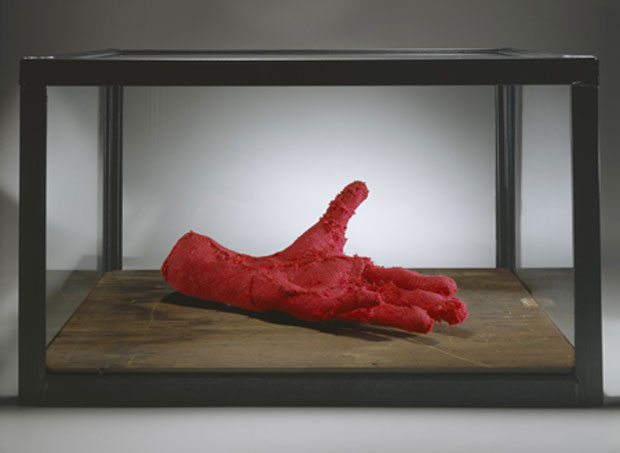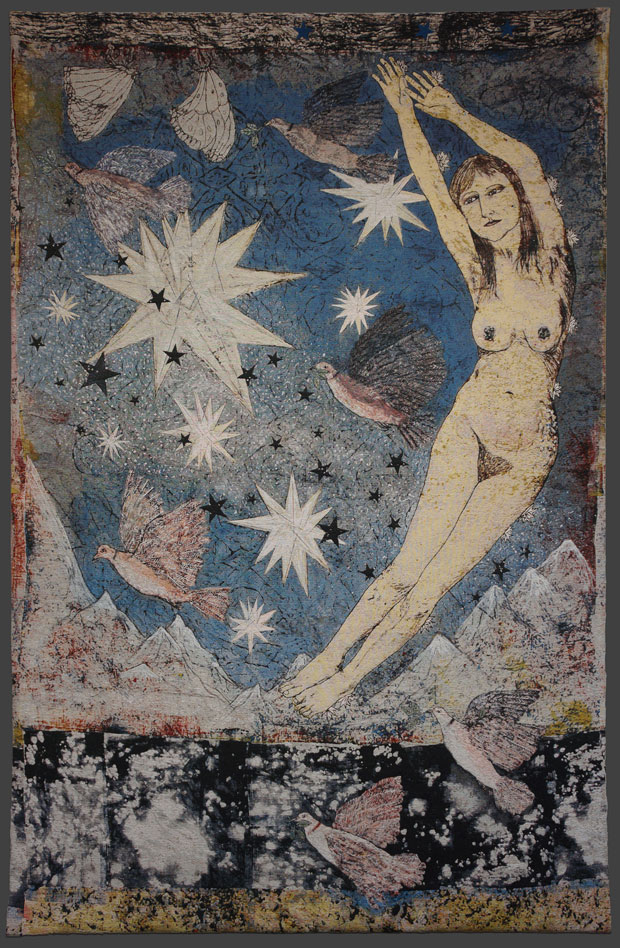For almost four years the critic Karen Wright wrote a weekly column for Radar, the Independent newspaper’s magazine, entitled ‘In The Studio’, which was based on nearly 200 visits to artists’ studios. As she puts it in her catalogue essay for ‘Entangled’, currently at Turner Contemporary, ‘Looking at what is lying around or pinned to the wall is often more interesting to me than an artwork in a gallery.’ This intimate encounter with artists immersed in their work – from Kiki Smith in the East Village, New York, instructing her assistants as they finalise the design for her dream-like tapestry Sky (2012), to Christiane Löhr bent over her meticulous constructions in horse hair, grasses, and seeds, in a shed outside Cologne – has inspired a show grounded in process and materials. The idea of textiles as women’s work – whether tapestry, stitching, knitting, weaving, knotting, embroidery – and how women respond to that idea is the second theme that drives the show. The entanglement alluded to in the exhibition’s title encompasses also the threads of inspiration running between artists of different generations, such as Swedish-born Norwegian weaver Hannah Ryggen (1894–1970) and the contemporary textile artist Ann Cathrin November Høibo, or the influence of Louise Bourgeois on generations of women artists in New York, including Eva Hesse, or the example Anni Albers provided for Sheila Hicks.

HAND, (2001), Louise Bourgeois. Courtesy Hauser & Wirth and Cheim & Read Photo: Christopher Burke, © The Easton Foundation/ VAGA, New York/DACS, London 2016.
The show champions textile as a primary medium for modern and contemporary art. We have here work by some of the greatest artists of the 20th century, including Bourgeois’s exact, stitched red HAND (2001), the canvas stitched over steel, evoking the frailty and the resilience of the human maker. There is a mesmerising tapestry designed by Anni Albers in 1926, a work of art exploring warp and weft, and some of Romanian conceptual artist Geta Brătescu’s intricate textile collages, like drawings in stitch, as well as the wonderful, mysterious ‘drawing with a sewing machine’, Hypostasis of Medea VIII (1980). There is no fetishising of the handmade – Mona Hatoum’s four rugs (made in Egypt between 1998 and 2015), like Albers’s wall-hanging and Smith’s tapestry, are woven by others to the artists’ designs. However, in other works, such as Sonia Gomes’s brilliantly-coloured and tightly stitched pieces or Sheila Hicks’s Minime sketches with a hand loom, the deployment of hand skill is part of their meaning.

Sky, (2012) Kiki Smith. Courtesy Timothy Taylor Gallery, London
Not everything is obviously textile: a low plinth is given to an installation of experimental pieces by Eva Hesse from 1969, made from cheese cloth and papier-caché (a kind of masking paper), which reveal a series of thoughts about material and form. Phyllida Barlow is represented by a joyful, jutting broken shelf of brightly painted flotsam bound with rag and tape, which defies gravity and asserts its chaotic presence. Ursula von Rydingsvard has produced especially for the show a new work, Thread Terror (2016), cut with a circular saw from massive 4 x 4 cedar beams, where the wood takes on the fluidity of ribbon or fabric. Later in the show there are also some of her exquisite, troubling textile wall hangings made from silk scarf, linen pulp, cotton threads and fabric, lace and deep black pigment.
Younger artists making inventive use of thread include Tatiana Trouvé, whose installation in New York’s Central Park, Desire Lines, a series of bobbins wound with coloured ropes representing the different paths through the park, is represented here by an impressive scale model and accompanying sewn walking maps. While there is a strong emphasis on the communal aspects of women’s art-making, with Anna Ray’s long wall-piece, Margate Knot, made with 20 local assistants, the first piece we see when we enter the room is Annette Messager’s witty Le Tutu Dansant (2013). This shop-bought black tutu (the dark sister of every little girl’s dream) hangs above a fan so that it dances to the music; it entirely escapes easy clichés about the handmade and collaborative nature of women’s art.
For while, as Siri Hustvedt’s polemical catalogue essay makes clear, this is an exhibition asserting the value of art by women, it is also better than that. These women resist containment. There is undoubtedly a feminine sensibility that runs through the exhibition, but just like the works of great male artists, whether they express political rage, despair, joy or passion, these textile works transcend gender.
‘Entangled: Threads and Making’ is at Turner Contemporary, Margate, from 28 January–7 May.














![Masterpiece [Re]discovery 2022. Photo: Ben Fisher Photography, courtesy of Masterpiece London](http://zephr.apollo-magazine.com/wp-content/uploads/2022/07/MPL2022_4263.jpg)
‘Like landscape, his objects seem to breathe’: Gordon Baldwin (1932–2025)